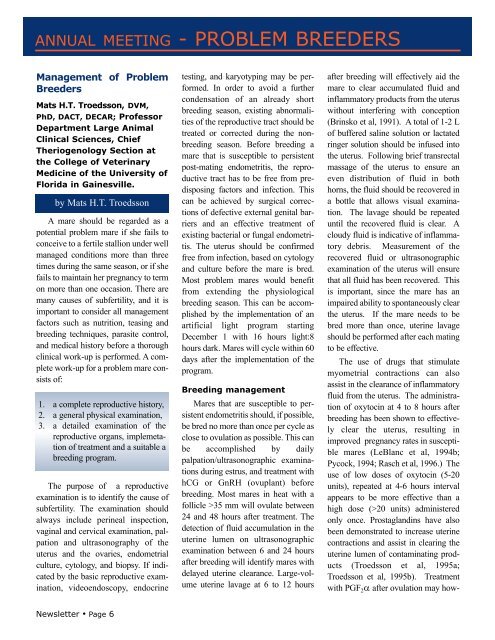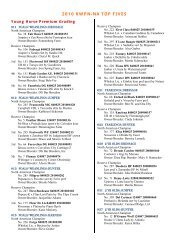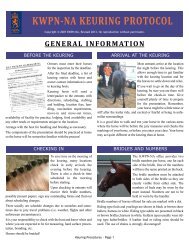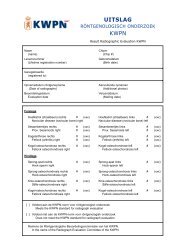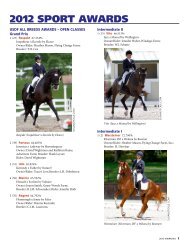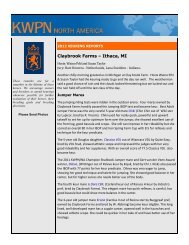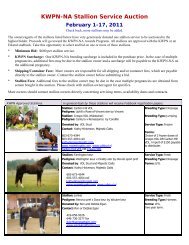Download PDF - KWPN
Download PDF - KWPN
Download PDF - KWPN
Create successful ePaper yourself
Turn your PDF publications into a flip-book with our unique Google optimized e-Paper software.
ANNUAL MEETING - PROBLEM BREEDERS<br />
Management of Problem<br />
Breeders<br />
Mats H.T. Troedsson, DVM,<br />
PhD, DACT, DECAR; Professor<br />
Department Large Animal<br />
Clinical Sciences, Chief<br />
Theriogenology Section at<br />
the College of Veterinary<br />
Medicine of the University of<br />
Florida in Gainesville.<br />
by Mats H.T. Troedsson<br />
A mare should be regarded as a<br />
potential problem mare if she fails to<br />
conceive to a fertile stallion under well<br />
managed conditions more than three<br />
times during the same season, or if she<br />
fails to maintain her pregnancy to term<br />
on more than one occasion. There are<br />
many causes of subfertility, and it is<br />
important to consider all management<br />
factors such as nutrition, teasing and<br />
breeding techniques, parasite control,<br />
and medical history before a thorough<br />
clinical work-up is performed. A complete<br />
work-up for a problem mare consists<br />
of:<br />
1. 1. a complete a complete reproductive history, history,<br />
2. a general physical examination,<br />
2. 3. a detailed a general examination physical examination, of the<br />
3. a detailed examination the<br />
reproductive organs, implemetation<br />
of treatment and a suitable a<br />
reproductive organs, and<br />
implementation of treatment and a suitable<br />
a breeding breeding program. program.<br />
The purpose of a reproductive<br />
examination is to identify the cause of<br />
subfertility. The examination should<br />
always include perineal inspection,<br />
vaginal and cervical examination, palpation<br />
and ultrasonography of the<br />
uterus and the ovaries, endometrial<br />
culture, cytology, and biopsy. If indicated<br />
by the basic reproductive examination,<br />
videoendoscopy, endocrine<br />
testing, and karyotyping may be performed.<br />
In order to avoid a further<br />
condensation of an already short<br />
breeding season, existing abnormalities<br />
of the reproductive tract should be<br />
treated or corrected during the nonbreeding<br />
season. Before breeding a<br />
mare that is susceptible to persistent<br />
post-mating endometritis, the reproductive<br />
tract has to be free from predisposing<br />
factors and infection. This<br />
can be achieved by surgical corrections<br />
of defective external genital barriers<br />
and an effective treatment of<br />
existing bacterial or fungal endometritis.<br />
The uterus should be confirmed<br />
free from infection, based on cytology<br />
and culture before the mare is bred.<br />
Most problem mares would benefit<br />
from extending the physiological<br />
breeding season. This can be accomplished<br />
by the implementation of an<br />
artificial light program starting<br />
December 1 with 16 hours light:8<br />
hours dark. Mares will cycle within 60<br />
days after the implementation of the<br />
program.<br />
Breeding management<br />
Mares that are susceptible to persistent<br />
endometritis should, if possible,<br />
be bred no more than once per cycle as<br />
close to ovulation as possible. This can<br />
be accomplished by daily<br />
palpation/ultrasonographic examinations<br />
during estrus, and treatment with<br />
hCG or GnRH (ovuplant) before<br />
breeding. Most mares in heat with a<br />
follicle >35 mm will ovulate between<br />
24 and 48 hours after treatment. The<br />
detection of fluid accumulation in the<br />
uterine lumen on ultrasonographic<br />
examination between 6 and 24 hours<br />
after breeding will identify mares with<br />
delayed uterine clearance. Large-volume<br />
uterine lavage at 6 to 12 hours<br />
after breeding will effectively aid the<br />
mare to clear accumulated fluid and<br />
inflammatory products from the uterus<br />
without interfering with conception<br />
(Brinsko et al, 1991). A total of 1-2 L<br />
of buffered saline solution or lactated<br />
ringer solution should be infused into<br />
the uterus. Following brief transrectal<br />
massage of the uterus to ensure an<br />
even distribution of fluid in both<br />
horns, the fluid should be recovered in<br />
a bottle that allows visual examination.<br />
The lavage should be repeated<br />
until the recovered fluid is clear. A<br />
cloudy fluid is indicative of inflammatory<br />
debris. Measurement of the<br />
recovered fluid or ultrasonographic<br />
examination of the uterus will ensure<br />
that all fluid has been recovered. This<br />
is important, since the mare has an<br />
impaired ability to spontaneously clear<br />
the uterus. If the mare needs to be<br />
bred more than once, uterine lavage<br />
should be performed after each mating<br />
to be effective.<br />
The use of drugs that stimulate<br />
myometrial contractions can also<br />
assist in the clearance of inflammatory<br />
fluid from the uterus. The administration<br />
of oxytocin at 4 to 8 hours after<br />
breeding has been shown to effectively<br />
clear the uterus, resulting in<br />
improved pregnancy rates in susceptible<br />
mares (LeBlanc et al, 1994b;<br />
Pycock, 1994; Rasch et al, 1996.) The<br />
use of low doses of oxytocin (5-20<br />
units), repeated at 4-6 hours interval<br />
appears to be more effective than a<br />
high dose (>20 units) administered<br />
only once. Prostaglandins have also<br />
been demonstrated to increase uterine<br />
contractions and assist in clearing the<br />
uterine lumen of contaminating products<br />
(Troedsson et al, 1995a;<br />
Troedsson et al, 1995b). Treatment<br />
with PGF 2 α after ovulation may how-<br />
Newsletter • Page 6


